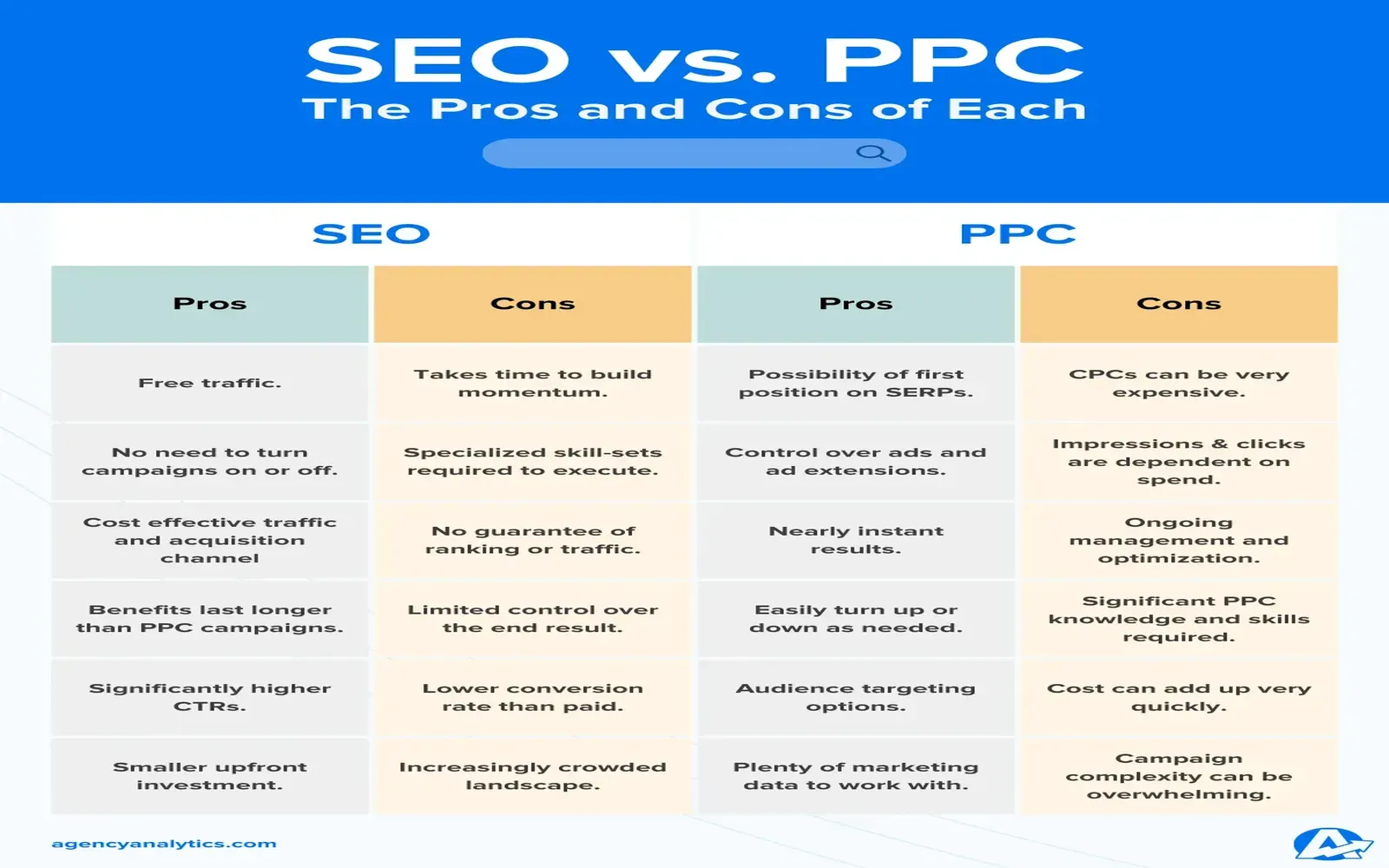
Business growth
Business growth refers to the process of improving a company's success and profitability through various strategies, including expanding market reach, increasing sales, enhancing operational efficiency, and innovating products or services. It involves strategic planning and execution to achieve long-term sustainability and competitiveness in the marketplace.

SEO vs. PPC: Which to choose for your growing business
Choosing between SEO and PPC for a growing business involves understanding their distinct advantages. SEO focuses on organic search visibility, building long-term traffic through content and optimization, while PPC offers immediate results through paid advertisements. Businesses aiming for sustainable growth may prefer SEO due to its cost-effectiveness over time, whereas those needing quick visibility might opt for PPC. Ultimately, the decision should align with the business's goals, budget, and target audience, often benefiting from a balanced approach that incorporates both strategies.

Copywriting vs. content writing: Which you need—and how to do them well
Copywriting and content writing serve distinct purposes in the realm of marketing. Copywriting focuses on persuasive techniques to drive immediate action, often seen in advertisements and sales pages. In contrast, content writing aims to inform and engage readers through informative articles and blog posts. To excel in either, understanding your target audience is crucial. Effective copywriting requires compelling headlines and clear calls to action, while successful content writing emphasizes storytelling and valuable insights that foster long-term relationships with readers.

Why your business shouldn't use a Gmail.com address, and what to use instead
Using a Gmail.com address for your business can undermine professionalism and credibility. It may signal to clients that your business lacks maturity and commitment. Instead, opt for a custom domain email that aligns with your business name, enhancing your brand’s identity and fostering trust. A professional email address not only improves communication but also reinforces your brand's legitimacy. Investing in a business email solution demonstrates your dedication to quality and helps create a lasting impression on clients and partners.

Why hiring neurodiverse employees is a win-win opportunity
Hiring neurodiverse employees offers unique advantages for organizations, fostering innovation and creativity through diverse perspectives. These individuals often possess exceptional skills in areas like problem-solving and pattern recognition, enhancing team performance. Embracing neurodiversity also promotes an inclusive workplace culture, improving employee morale and retention. By tapping into the strengths of neurodiverse talent, companies can not only drive business success but also contribute to a more equitable society, making it a mutually beneficial opportunity for both employers and employees.

Why client onboarding may be blocking business growth (and how to un-block it)
Client onboarding can often become a bottleneck for business growth due to inefficient processes, lack of personalization, or inadequate resources. These obstacles can lead to client frustration and disengagement, ultimately affecting retention and referrals. To unblock this growth, businesses should streamline onboarding procedures, leverage technology for automation, and focus on creating a tailored experience for each client. By enhancing communication and support during this critical phase, companies can foster stronger relationships and drive long-term success.

Start small: Getting your first customers through small-scale marketing tactics
Starting small in business often involves utilizing cost-effective marketing strategies to attract your first customers. Focus on local outreach, social media engagement, and word-of-mouth recommendations to create awareness. Building relationships within your community can lead to organic growth, while targeted promotions can draw attention to your offerings. By prioritizing genuine connections and personalized experiences, you can establish a loyal customer base without the need for extensive budgets, ultimately laying a strong foundation for future expansion.

The landing page guide: How to promote your product on one web page
This guide provides essential insights on creating an effective landing page to promote your product. It covers key elements such as crafting compelling headlines, writing persuasive copy, and utilizing eye-catching visuals to engage visitors. The guide emphasizes the importance of a clear call to action and optimizing the page for conversions. By following the outlined strategies, marketers can enhance their online presence, attract potential customers, and ultimately drive sales—all within the confines of a single, impactful web page.

When launching a small business, fortune favors the bold
Launching a small business requires courage and a willingness to take calculated risks. Bold entrepreneurs often seize opportunities that others might overlook, driving innovation and growth. Embracing uncertainty and stepping outside comfort zones can lead to unique solutions and competitive advantages. While careful planning is essential, the readiness to adapt and pursue ambitious goals can distinguish successful ventures from those that remain stagnant. Ultimately, fortune may favor those who dare to take the plunge and pursue their entrepreneurial dreams with confidence.

Why it's time to buck traditional pricing structures
In today's rapidly evolving market, traditional pricing structures often hinder innovation and growth. Businesses must adapt to changing consumer behaviors and preferences, exploring dynamic pricing models that reflect real-time demand and value. By embracing flexibility, companies can enhance customer satisfaction, improve competitiveness, and optimize revenue streams. This shift allows for personalized pricing strategies that resonate with individual customers, fostering loyalty and engagement. Ultimately, challenging outdated pricing norms opens the door to new opportunities and sustainable success in a digital economy.

The secret about paying less taxes that accountants don't want small business owners to know
Many small business owners are unaware of the tax strategies that can significantly reduce their tax liabilities. Accountants often focus on standard deductions and credits, but there are lesser-known options that can lead to substantial savings. These may include leveraging tax credits for specific industries, maximizing retirement contributions, and utilizing business expenses more effectively. By understanding these strategies, small business owners can take control of their finances and keep more of their hard-earned money instead of overpaying on taxes.

These 5 legal essentials can help protect your growing business
Protecting a growing business involves understanding and implementing key legal essentials. Establishing a solid business structure, such as an LLC or corporation, can limit personal liability. Drafting comprehensive contracts ensures clear agreements with clients and suppliers, minimizing disputes. Intellectual property protection safeguards unique ideas and branding. Complying with employment laws helps create a fair workplace and reduces the risk of litigation. Finally, obtaining the right insurance coverage provides financial protection against unforeseen circumstances, securing your business’s future.

The value of transparency: Letting your customers see the data you see
Transparency in business fosters trust and loyalty by allowing customers to access the same data that informs decision-making. When companies share insights into their processes, pricing, and performance metrics, it empowers consumers to make informed choices and enhances their overall experience. This openness not only strengthens relationships but also encourages accountability and continuous improvement. By letting customers see the data you see, businesses can cultivate a more engaged and informed customer base, ultimately driving success and innovation.

How tracking my time helped me increase revenue in my business
Tracking my time transformed my approach to business management and significantly boosted my revenue. By meticulously logging how I spent each hour, I identified areas where I was wasting time and opportunities for optimization. This newfound awareness allowed me to focus on high-impact tasks, delegate effectively, and eliminate distractions. As a result, my productivity soared, leading to increased client satisfaction and an uptick in sales. The simple act of tracking time became a powerful tool for driving financial growth.

Customer reviews: The most important small business marketing strategy
Customer reviews play a crucial role in small business marketing by building trust and credibility. Positive feedback from satisfied customers can significantly influence potential buyers, enhancing a business's reputation and attracting new clientele. Additionally, reviews provide valuable insights into customer preferences and experiences, allowing businesses to improve their products and services. Engaging with reviews, both positive and negative, demonstrates a commitment to customer satisfaction and fosters loyalty, making it an essential strategy for growth and success in a competitive market.

The importance of real-time financials for scaling companies
Real-time financials play a crucial role for scaling companies by providing immediate insights into cash flow, profitability, and overall financial health. This timely information enables decision-makers to respond quickly to market changes, optimize resource allocation, and identify growth opportunities. With accurate financial data at their fingertips, businesses can enhance their strategic planning, improve operational efficiency, and foster investor confidence. Ultimately, real-time financial visibility is essential for navigating the complexities of growth and sustaining a competitive edge in the market.

How to reliably scale an eCommerce business
To reliably scale an eCommerce business, focus on optimizing your website for user experience and mobile responsiveness. Invest in targeted digital marketing strategies, leveraging social media and SEO to reach your audience effectively. Streamline operations by automating processes and enhancing inventory management. Build strong relationships with suppliers to ensure product availability and quality. Analyze customer data to understand buying behaviors and preferences, enabling personalized marketing and improved customer retention. Lastly, continuously adapt and innovate based on market trends and feedback.

How to use local competitors to your advantage
Analyzing local competitors can provide valuable insights for your business strategy. Start by identifying their strengths and weaknesses, particularly in areas like pricing, customer service, and product offerings. Use this information to differentiate your brand, emphasizing unique selling points that appeal to your target audience. Additionally, consider collaborating with local businesses for joint promotions or community events, which can enhance your visibility and credibility. By leveraging competitor insights, you can refine your approach and better meet the needs of your customers.

How to know when it's time to hire your first employee
Deciding when to hire your first employee involves assessing your workload and business growth. If you're consistently overwhelmed with tasks that hinder your ability to focus on strategic goals, it may be time to bring someone on board. Consider your financial stability and whether you can afford to pay a salary without jeopardizing your business. Additionally, look for signs such as missed opportunities or declining customer satisfaction, which indicate that extra help could enhance productivity and support future growth.

Leading in a new video-centric business environment
In today's rapidly evolving business landscape, leaders must adapt to a video-centric environment that prioritizes visual communication and engagement. This shift requires an understanding of digital tools and platforms that facilitate collaboration and connection among remote teams and clients. Effective leadership now involves leveraging video for presentations, meetings, and marketing strategies, fostering a culture of transparency and inclusivity. Embracing this medium not only enhances brand visibility but also empowers organizations to build stronger relationships in an increasingly virtual world.

Preparing for success: Lessons learned from early mistakes in a small business
Preparing for success in a small business often involves learning from early mistakes. Entrepreneurs frequently encounter challenges such as mismanaging finances, underestimating market research, and neglecting customer feedback. These initial setbacks can provide invaluable lessons, teaching the importance of adaptability and resilience. By reflecting on past errors, business owners can develop effective strategies, foster stronger relationships with clients, and create a more sustainable model. Ultimately, embracing these lessons paves the way for future growth and success in the competitive landscape.